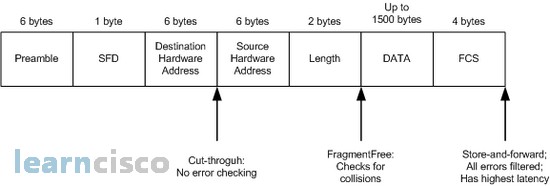LAN switch types decide how a frame is handled when it’s received on a switch port. Latency- the time it takes for a frame to be sent out an exit port once the switch receives the frame- depends on the chosen switching mode. There are three switching modes:
- Cut-through (FastForward) – When in this mode, the switch only waits for the destination hardware address to be received before it looks up the destination address in the MAC filter table. Cisco sometimes calls this the FastForward method.
- FragmentFree (modified cut-through) – This is the default mode for the Catalyst 1900 switch, and it’s sometimes referred to as modified cut-through. In FragmentFree mode, the switch checks the first 64 bytes of a frame before forwarding it for fragmentation, thus guarding against forwarding runts, which are caused by collisions.
- Store-and-forward – In this mode, the complete data frame is received on the switch’s buffer, a CRC is run, and, if the CRC passes, the switch looks up the destination address in the MAC filter table.
The following image delimits the different points where the switching mode takes place in the frame.

Cut-Through (Real Time)
You may see Cisco call this cut-through, FastForward, or even real time. With the cut-through switching method, the LAN switch reads only the destination address (the first six bytes following the preamble) onto its onboard buffers. That done, it then looks up the hardware destination address in the MAC switching table, determines the outgoing interface, and proceeds to forward the frame toward its destination.
A cut-through switch really helps to reduce latency because it begins to forward the frame as soon as it reads the destination address and determines the outgoing interface. With some switches, you get an extra super-cool feature: the flexibility to perform cutthrough switching on a per-port basis until a user-defined error threshold is reached. At the point that threshold is attained, the ports automatically change over to store-and-forward mode so they will stop forwarding the errors. And when the error rate on the port falls back below the threshold, the port automatically changes back to cut-through mode.
FragmentFree (Modified Cut-Through)
FragmentFree is a modified form of cut-through switching in which the switch waits for the collision window (64 bytes) to pass before forwarding. This is because if a packet has a collision error, it almost always occurs within the first 64 bytes. It means each frame will be checked into the data field to make sure no fragmentation has occurred. FragmentFree mode provides better error checking than the cut-through mode with practically no increase in latency. It’s the default switching method for the 1900 switches.
Store-and-Forward
Store-and-forward switching is Cisco’s primary LAN switching method. The store-and-forward method provides efficient, error-free transport instead of fast transport. When in storeand- forward, the LAN switch copies the entire frame onto its onboard buffers and then computes the cyclic redundancy check (CRC). Because it copies the entire frame, latency through the switch varies with frame length.
The frame is discarded if it contains a CRC error-if it’s too short (less than 64 bytes including the CRC) or if it’s too long (more than 1518 bytes including the CRC). If the frame doesn’t contain any errors, the LAN switch looks up the destination hardware address in its forwarding or switching table to find the correct outgoing interface. When it does, out goes the frame toward its destination.
Our Recommended Premium CCNA Training Resources
These are the best CCNA training resources online:
Click Here to get the Cisco CCNA Gold Bootcamp, the most comprehensive and highest rated CCNA course online with a 4.8 star rating from over 30,000 public reviews. I recommend this as your primary study source to learn all the topics on the exam.

Want to take your practice tests to the next level? AlphaPreps purpose-built Cisco test engine has the largest question bank, adaptive questions, and advanced reporting which tells you exactly when you are ready to pass the real exam. Click here for your free trial.
